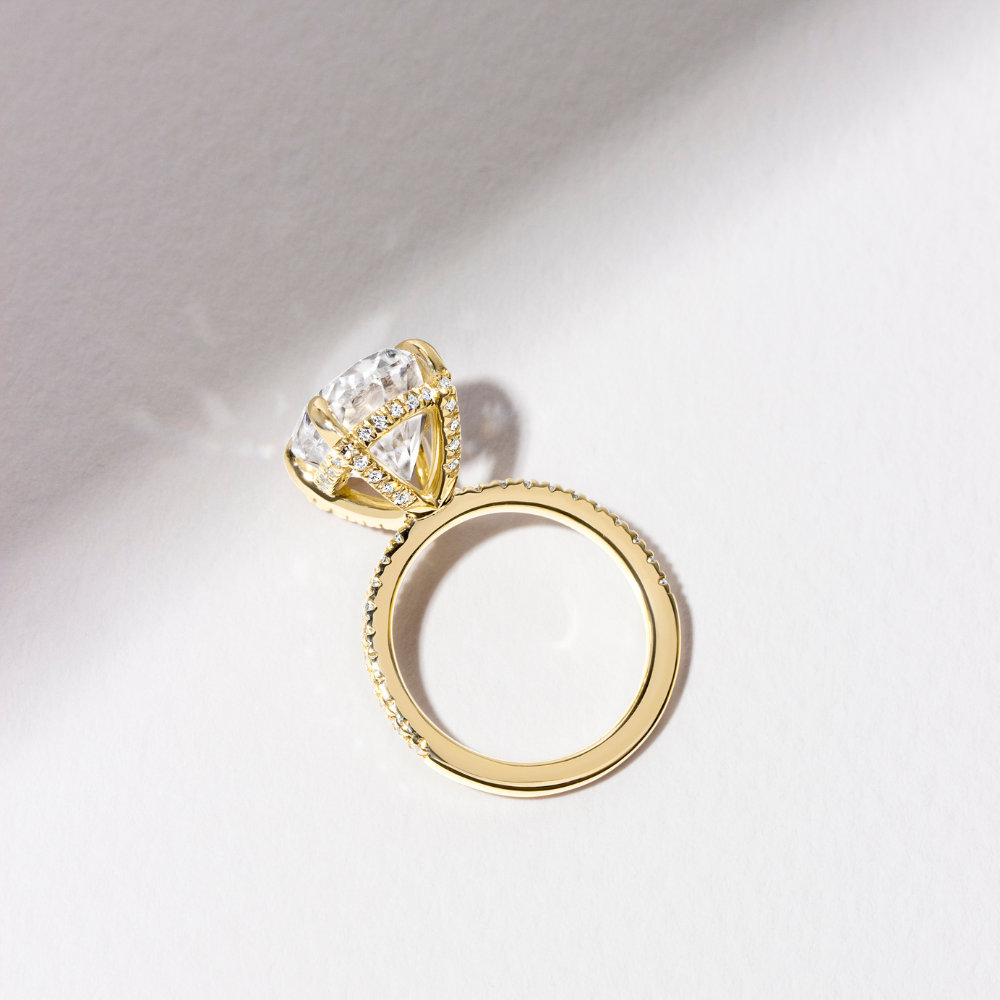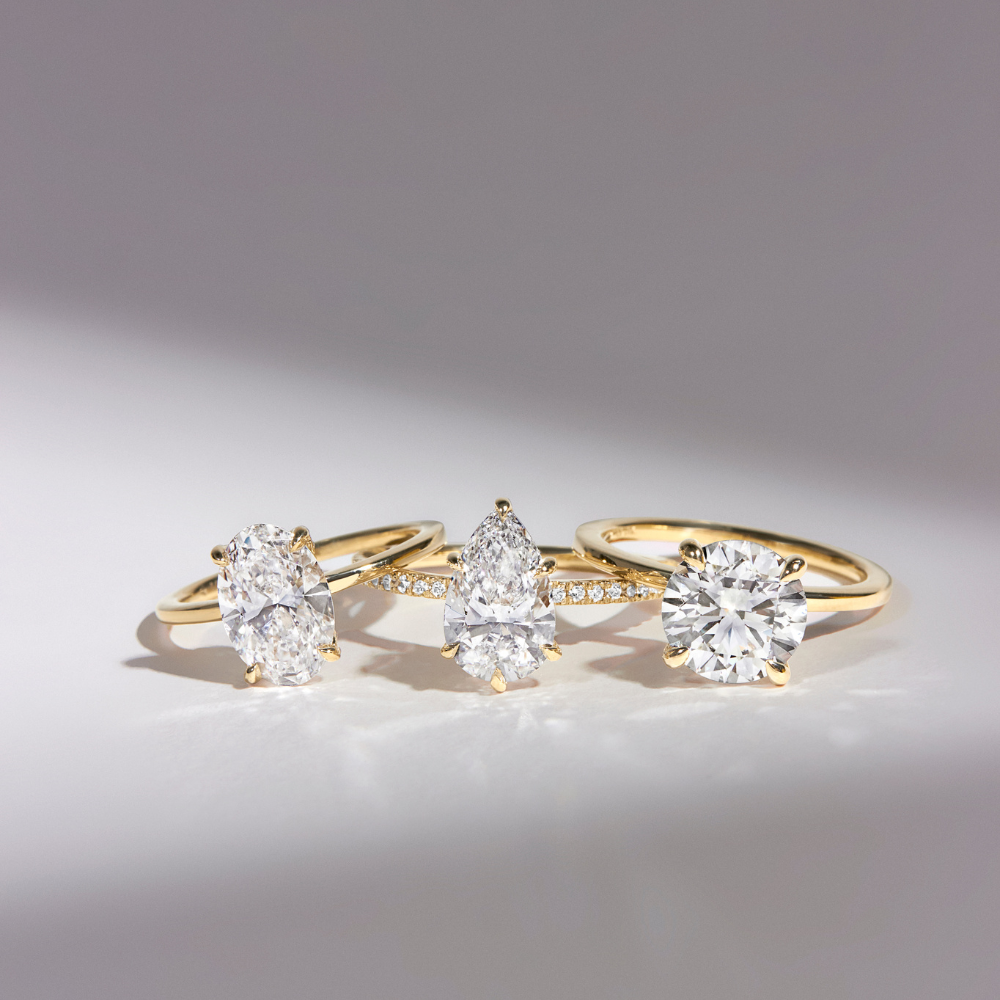
An engagement ring is more than just a piece of jewelry—it’s a symbol of love, commitment, and often a significant investment. Proper care is essential to maintaining its brilliance and ensuring it lasts a lifetime. In this guide, we provide practical advice on how to care for your engagement ring. From daily habits to avoid to tips for professional maintenance, our goal is to help you keep your ring in pristine condition.
How to Take Care of Your Engagement Ring
Regular Cleaning
Keeping your engagement ring clean is important to maintain its sparkle. Over time, lotions, soaps, and everyday dirt can cause buildup, dulling the ring’s appearance. We recommend cleaning your ring at home once a week and having it professionally cleaned about every six months. When cleaning your ring at home, avoid abrasive cleaners (like baking soda) and ultrasonic cleaners. For more cleaning tips, read our At-Home Cleaning Guide.
Annual Inspections
Consider having your engagement ring inspected by a professional jeweler about once a year. During an inspection, the jeweler will check for loose prongs, worn mountings, and any other signs of wear that could cause the stone to fall out or the ring to become damaged. The jeweler can also determine if your ring needs to be polished or replated. Regular inspections can prevent small issues from becoming costly repairs, ensuring the ring remains secure and beautiful.
Proper Storage
When you’re not wearing your engagement ring, store it in a safe, designated place. When you briefly remove your ring, like when putting on lotion or washing dishes, it can be helpful to have ring dishes in those areas for easy placement. For longer removal, use a jewelry box with a soft lining or a fabric pouch to prevent scratches and minimize exposure to air and moisture. Storing your ring separately from other jewelry can also prevent it from being scratched or damaged by harder gemstones or metals.
Insurance
Insuring your engagement ring is an important step in protecting your investment. Jewelry insurance covers the cost of repair or replacement in case of theft, loss, or damage. To learn more about ring insurance, read our guide.
Protection from Impact
Engagement rings, especially those with high settings or delicate prongs, can be vulnerable to damage from hard impacts. Activities such as lifting weights or playing sports can cause prongs to bend or stones to become loose. Remove your ring during these activities to protect it from accidental bumps and scratches.

10 Things You Should Never Do While Wearing Your Engagement Ring
1. Don’t Wear Your Ring to the Gym
Engaging in physical activities such as sports or heavy lifting can subject your ring to unnecessary wear and tear. These activities increase the risk of bending prongs, loosening stones, or even breaking the band. Always remove your ring before engaging in any strenuous physical activity.
2. Avoid Wearing Your Ring in Water
Whether you’re swimming in a pool or relaxing in a hot tub, water can pose a risk to your engagement ring. Chlorine can damage the metal settings, and cold water can cause your fingers to shrink, increasing the risk of losing your ring. Make it a habit to remove your ring before any water-based activities.
3. Never Apply Skin Care, Lotion, or Makeup While Wearing Your Ring
Lotions, creams, and cosmetics can leave a residue on your ring, dulling its shine and potentially damaging softer gemstones. Before applying any beauty products, remove your ring to keep it clean and free from buildup.
4. Don’t Sleep with Your Ring On
Wearing your ring while you sleep can cause the band to bend or prongs to loosen, especially if you are a restless sleeper. Additionally, it can snag on sheets or hair. To keep your ring in optimal condition, remove it before bedtime.
5. Avoid Handling Harsh Chemicals
Harsh chemicals found in cleaning products, perfumes, and hair sprays can discolor and corrode the metal of your ring. Before using any products that contain strong chemicals, remove your ring to prevent accidental exposure.

6. Do Not Wear Your Ring at the Beach
Wearing your engagement ring at the beach is risky due to the combination of sand, water, and sunscreen. Sand can scratch the metal and stones, while cold water can cause your fingers to shrink, increasing the risk of the ring slipping off. Additionally, sunscreen can leave a residue on your ring, dulling its shine. Always remove your ring before heading to the beach.
7. Avoid Wearing Your Ring While Doing Dishes
Washing dishes can expose your engagement ring to harsh detergents and hot water, which can damage both the metal and the stone. There is also a risk of the ring slipping off and getting lost down the drain. Remove your ring before doing any dishwashing to prevent damage or loss.
8. Do Not Wear Your Ring While Cooking
When working with raw meats or greasy foods, cooking can introduce bacteria and oils into the crevices of your ring. This can cause buildup and diminish its sparkle. Remove your ring before preparing food to keep it clean and sanitary.
9. Avoid Yardwork While Wearing Your Ring
You should avoid wearing your engagement ring during yardwork because it can expose the ring to potential damage from dirt, rocks, and gardening tools. The rough materials and heavy equipment used during yardwork can cause scratches, dents, or even bend the metal of the ring. Soil and debris can also become trapped in the setting, making it difficult to clean. Additionally, vigorous activities such as digging, raking, or lifting heavy objects increase the risk of bending prongs or knocking stones loose.
10. Do Not Apply Hand Sanitizer While Wearing Your Ring
Hand sanitizer contains alcohol and other chemicals that can dull the finish of your ring. We recommend removing your ring before applying hand sanitizer and waiting until your hands are dry before putting it back on. If you are in a public place or on the go and don’t want to risk removing your ring, carefully apply the hand sanitizer around your ring.

Engagement Ring Care FAQs
Can I wear my engagement ring in the shower?
It is not recommended to wear your engagement ring in the shower. Showering with your ring on can expose it to soaps, scrubs, shampoos, and conditioners that can cause a film to build up on the diamond or gemstone, dulling its sparkle.
Can I wash my hands with my engagement ring on?
It is generally safe to wear your engagement ring while washing your hands, as long as you use a mild, gentle soap and avoid harsh or abrasive cleansers. However, frequent handwashing, especially with harsh soaps and hot water, can cause gradual wear over time. There’s also a small risk of your ring slipping off in soapy water. If you want to be extra cautious, consider removing your ring and placing it in a safe place before washing your hands, and always ensure your hands are completely dry before putting it back on.
Proper engagement ring care is essential to preserving its beauty and value. Remember, a little attention and care go a long way in maintaining the brilliance and integrity of your engagement ring.




